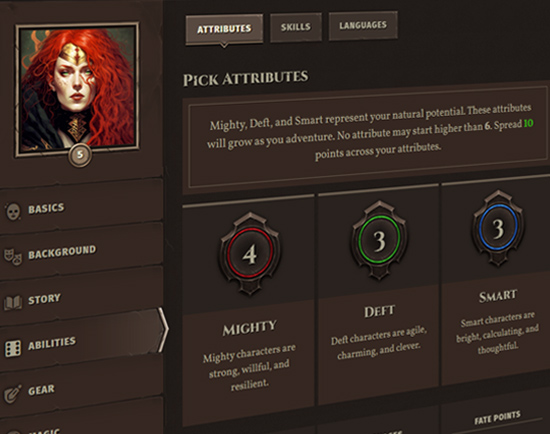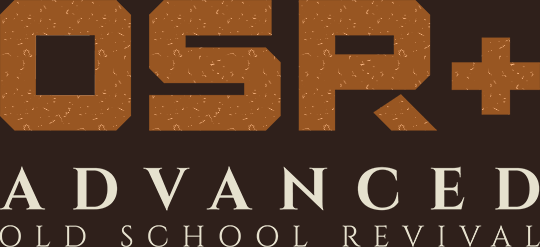A chase scene is a special type of encounter where the persons fleeing are considered the prey, and the persons chasing are considered the hunters. The chase scene is tracked by a pursuit die called the clock (typically a d6), where escape means exceeding the maximum face (6) and capture means exceeding the lowest face (1).
Structure of the Pursuit
The GM establishes a clock via the pursuit die for the chase, typically starting with 3 on a d6. A clock with a higher pursuit die (such as a 5 on a d10) results in longer chase scenes.
In a chase scene, you (and your party members) are either prey or hunter: while actions are resolved individually as you would in a regular encounter, hunter and prey each roll once for their side, to determine which side acts first. The goal of each round is to use your actions to create more success than your opponents.
- Each side rolls for initiative. Choose someone in your party to roll. If anyone on either side has Perception, add a +2 to the roll.
- When your side's initiative is up, your side acts in any order you wish. The GM resolves any action you take with one of the pursuit tactics in the Pursuit Tactics table below.
- Whichever side generates the most success as a result of their actions moves the clock in their favor. The clock always moves 2 faces.
- If the clock is ever lower than the lowest face of the pursuit die, the hunter catches the prey; if the clock is ever higher than the highest face, then the prey escapes the hunter.
About Actions in Pursuit
A single round in a chase scene could be anywhere from a minute to ten minutes or more: the passage of time is abstract, as determined by the GM. For this reason, the GM treats actions taken in the scene the same way he would treat actions taken in a scene check: that is, all spells and other effects that would have an impact over time only last for as long as the single round in which they're used.
Similarly, the effect of any action taken in the chase can only ever take its target out of commission for a single round, unless that effect would incapacitate the target. For example: if you successfully put your hunter to sleep via a Sleep spell or poison, well then there's no longer a need to continue the chase, now is there?
This is because all individual actions on either side represent what that side accomplished to impact the chase overall, in the same way that the party’s actions in a scene check model the overall outcome of the scene. The GM must make common sense rulings as to what mechanical effects (especially from spells) are respected by the chase.
Moving the Clock
During a chase, you can take any action you'd ordinarily take in encounter mode, but the GM resolves your action as one of the pursuit tactics listed below, in order to determine whether it generates success towards moving the clock in the round. Whichever side has the most success at the end of the round moves the clock by 2 faces.
Actions left uncontested by either party automatically generate success for the side that originates them. When you contest something your opponent has done, you're trying to thwart the success of their actions rather than what they actually did. This is so that they don't gain a leg up in the chase.
Pursuit TACTICS Table
| Tactic | Example |
|---|---|
| Flee or Overtake | These are the default actions the prey and hunter take, respectively. If left uncontested at the end of the round, these actions earn success automatically. |
| Contest or Evade | To contest a success the other side has earned or to evade an obstacle in your way, you have to make a contested check. This does not earn you success, but it prevents the other side from earning success. |
| Create an Obstacle | You create an obstacle that misleads or distracts your opponent the next time your opponent acts. The GM chooses an appropriate attribute and you make a success check. (See the Pursuit Tactics table.) |
| Attack | You make an attack against an opponent on the other side that they must immediately defend. While both of you use encounter mechanics to model the attack and defense, the outcome of a successful attack is that you reduce success on the opponent's side and you don't earn any success. The attacked opponent may still act to generate success on their side's turn, however. |
Action Economy in the Chase
Both sides in a chase need to start with an equivalent number of actions for the chase to be a challenge mechanically. So if there is 1 prey and 5 hunters, the GM may balance things out by grouping NPCs into a single action. If there is a group of hunters and a single prey, the GM may make the hunters act collaboratively, so the action is 1:1. Alternatively, he may have the party act together via a single-act scene check if there's only 1 hunter.
Environmental Obstacles
The GM may create random obstacles from the environment within which the chase takes place, in order to balance out the actions on each side or create further challenges. For example, if there is only 1 monster pursuing you and you're in a party with 3 heroes, the GM may introduce additional obstacles from the environment each round in order to keep things balanced (e.g., crowds of people getting in the way or wreckage toppling over).
Resolving the Chase
As either side takes action in the round, the GM keeps track of each success generated.
For example, suppose you're the prey in a party of 3. A single giant monster is pursuing you. The clock is set to 3 on a d6. You win the first initiative, so your party members decide to do the following:
- PC 1 pushes the driver out of a horse-drawn carriage so everyone can hop aboard to pick up speed. This action resolves to Flee or Overtake. The GM lets this happen without rolling because there's no meaningful chance of failure.
- PC 2 Creates an Obstacle by pushing over a vendor's cart and spillings its contents into the street, for the monster to contend with when it acts. The GM calls for a Mighty success check with results from the Pursuit Tactics table, because it might be interesting if say the vendor thwarted the player or the player fumbled trying to do this while running away. If the monster does not evade the obstacle on its next action, this will score the PCs success.
- PC 3 blasts the monster with the cold maleficence to slow it down, which is an Attack (the PC rolls for this as he would normally in an encounter); if the attack succeeds, the monster's success is reduced by 1. This does not earn the PC success.
At this point the party has the potential to create 2 successes from PC 1 and PC 2, as long as what they did goes uncontested by the end of the round. Player 3 made an attack, which does not generate success, but if the attack is successful, the monster starts with 1 fewer success.
Now the monster acts. The GM decides to give the monster 2 actions and create a third obstacle from the environment to balance things out:
- The monster flings out a tentacle to grab one of the PCs off the back of the cart. This counts as an Attack. The monster resists the cold maleficence (negating the PC's attempt to reduce its success) and its attack reduces the PCs' success by 1. Now one of the PCs is entangled next turn and will have to spend their action breaking free from its grasp.
- The monster tries to leap over the contents of the vendor cart that PC 2 spilled into the street (Contest or Evade), but because it's rather clumsy, it fails. This is handled as a contested Deft check vs. the target number (TN) of the Mighty check the PC rolled to create the obstacle.
- The GM creates an obstacle from the environment: the PCs, steered off course by the debris, realize they're headed into the middle of a heavily populated street performance taking place in the town square. If one of the PCs uses their action to Contest or Evade the obstacle on their next action, they will have to make a Deft success check with results from the Pursuit Tactics table.
Overall, the monster's side didn't earn any success and the PCs earned 1 success (because the monster reduced their success with an attack). The clock moves in the PCs' favor by 2 points.
Pursuit Tactics Table
The table below may be used by the GM to help adjudicate the results of uncontested checks involving creating or evading obstacles: this is a success check table with outcomes tailored to help model the chase.
Keep in mind the GM doesn't have to use this table for adjudication. He may choose to apply GM advantage or player advantage instead, if it makes more sense in the fiction.
| target number | Create an Obstacle | EVADE an Obstacle |
|---|---|---|
| Poor (5+) | The GM creates an obstacle against you. | You fail to evade the obstacle and the GM creates an obstacle against you. |
| Average (7+) | While you succeed at creating the obstacle, the opposing side has advantage on all checks against it. | You evade the obstacle but your side carries forward a -2 on your next attempt to evade an obstacle. |
| Good (11+) | You succeed in creating the obstacle. | You succeed in evading the obstacle. |
| Exceptional (13+) | You succeed in creating the obstacle and the opposing side has disadvantage against it. | You evade the obstacle and your side carries forward a +2 on your side's next attempt to evade an obstacle. |
| Extraordinary (17+) | You create 2 obstacles. | You gain 2 successes from evading the obstacle. |
| Legendary (21+) | You create 2 obstacles and the opposing side has disadvantage against them. | You gain 2 successes from evading the obstacle and carry forward a +2 on your side's next attempt to evade an obstacle. |
 Armor
Armor Classes
Classes Conflicts
Conflicts Ethos
Ethos Flaws
Flaws Kits
Kits Maleficence
Maleficence Origins
Origins Shields
Shields Skills
Skills Spells
Spells Stances
Stances Tactics
Tactics Talents
Talents Treasure
Treasure Weapons
Weapons











 Hall of Heroes
Hall of Heroes Hall of Legends
Hall of Legends Dungeons & Flagons
Dungeons & Flagons